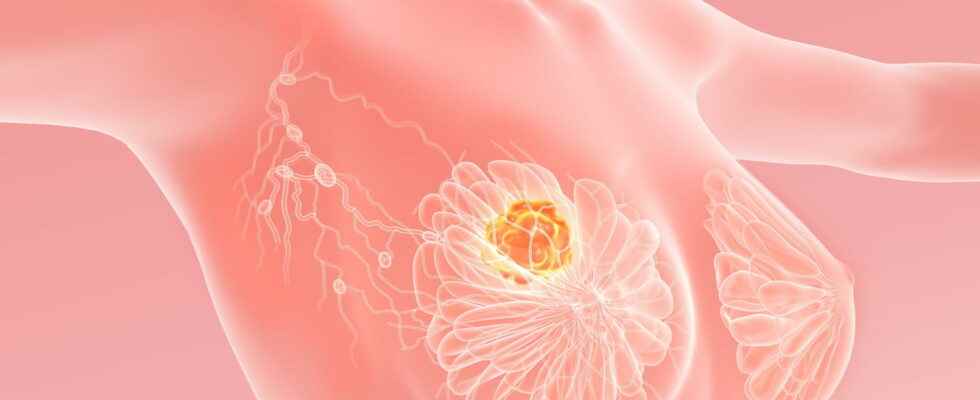Shiloh, a 12-year-old French girl, died of breast angiosarcoma, a very rare but very aggressive malignant breast tumor with a poor prognosis. What is this type of cancer? What are the warning symptoms? The treatment ? The ranks? The survival rate? Focus.
Shiloh, a 12 year old girldied in December 2021 of a breast angiosarcomaa breast tumor of vascular origin very rare, very aggressive and difficult to diagnose, relay our colleagues from Parisian in an article of May 23, 2022. The teenager, whose diagnostic journey was tedious and the treatment difficult, “presented a swollen, hot and painful breast, symptoms that clinically suggested an inflammatory or infectious process of the mastitis (inflammation of the breast sometimes of an infectious nature), infinitely more common than cancer at this age. The pathology suffered by this child presents an exceptional character“nevertheless reports the Parisian, citing one of the practitioners who participated in the care of Shiloh. What is this tumor? What are the warning symptoms? How is the diagnosis made? What is the treatment ? the prognosis of survival? Discovery.
Definition: what is breast angiosarcoma?
The breast is one of the most common locations after the skin of the head and neck
L’angiosarcoma is a malignant tumor of vascular origin, very rare and with a very grim diagnosis, defines theInsermwhich can grow in all types of tissues. the breast is one of the most frequent localizations after the skin of head and neck : we thus speak of a breast angiosarcoma. This type of tumor is characterized by a strong malignancy and a polymorphic clinical and radiological presentation, source of diagnostic errors and delays.
How common is breast angiosarcoma?
Its prevalence among malignant breast tumors is 0.04% and represents 8% of breast sarcomasreports a 2013 study published on the medical platform EM Consulte. For information, Gustave Roussy mentions 8 cases treated at the Institute in the space of 40 years (between 1954 and 1995), among women at least 32 years old.
At what age does breast angiosarcoma appear?
There are two types of breast angiosarcoma:
- Primary angiosarcoma which touches the young woman (between 30 and 40 years old) with no known risk factor.
- Secondary angiosarcoma which mainly occurs in older women (average age of 69 years old) probably treated with radiotherapy as part of the conservative treatment of breast cancer.
What are the symptoms of breast angiosarcoma?
Most of the time, breast angiosarcoma presents as the form of a painless swellingbut without axillary adenopathy (swollen glands in the armpit). Sometimes breast angiosarcoma causes symptoms like:
On clinical examination:
- A localized change in skin color suggestive of a vascular tumor (purplish colordark).
- Induration (hardening of the skin) at the lower part of the nipple,
On imaging:
- A poorly limited nodule formed of coalescing (abnormally touching) and dense vegetation
- An aspect of coalescing “soap bubbles”.

After suspicion of a breast tumor on clinical examination, examinations are to be carried out to guide and make the diagnosis:
- A Breast ultrasound.
- A Breast MRI.
- The mammography is not always indicated: it is not specific, and the tumor is often difficult to see in young women with dense breasts.
- If necessary, breast biopsies (both superficial (cutaneous) and deep (right periareolar))
What are the grades of breast angiosarcoma?
Breast angiosarcoma can be grade 1, 2 or 3, determined by its characteristics.
► Grade 1 breast angiosarcoma (low grade):
- Braided vessels
- Rare endothelial tufts
- Some hyperchromatic endothelial cells
- Absent or rare mitoses
- Absence of necrosis
► Grade 2 breast angiosarcoma (intermediate grade):
- Some foci of papillary formation
- Massive zones arranged in fusiform cells
- Representing less than 20% of the tumor
- Cellular atypia and mitoses
- Absence of necrosis
► Grade 3 breast angiosarcoma (ranking officer) :
- Predominance of massive zone with spindle cells
- Marked cellular atypia
- Many mitoses
- Focus of hemorrhagic necrosis
- Exceptional grade 1 appearance
What is the treatment for breast angiosarcoma?
Except surgery when the tumor is still localized (breast removal), there is no consensus on the treatment of this cancer resistant to conventional chemotherapy, advances Inserm. Nevertheless, in 2013, an Inserm team from the Timone hospital (in Marseille) designed a therapeutic strategy combining two new approaches for the management of mammary angiosarcoma:
► Propranolol: an antihypertensive administered to overcome the side effects of conventional treatment (high-dose corticosteroids), caused the tumors to regress rapidly.
► The metronomic chemotherapy. “In conventional chemotherapy, the sessions are spaced two to three weeks apart to allow the patient to recover from the toxic effects of the treatment. However, the tumor takes advantage of this to revascularize and progress. Metronomic therapy therefore consists of give more frequent doses, to prevent tumor progression, but weaker to limit toxicity”explains Eddy Pasquier, from unit 911 of Inserm/Aix-Marseille University, Center for Research in Biological Oncology and Oncopharmacology. In total, the patient can receive at least as much product as in conventional therapy, but with improved tolerance”.
A survival of 15 years (grade 1) to 15 months (grade 3)
What is the survival prognosis for breast angiosarcoma?
Breast angiosarcoma is very bad prognosis Due to the frequent occurrence of visceral metastases and rapid recurrence. The prognosis depends on the histological grade (see grade section above) of the tumour, with 10-year survival for all forms (primary or secondary).
► Angiosarcoma has a prognosis with a median survival of 15 years old for grades I,
► Angiosarcoma has a prognosis with a median survival of 12 years for II grades
► Angiosarcoma has a prognosis with a median survival of only 15 months for grade III.
Sources: A new therapeutic strategy against angiosarcoma, Inserm / Mammary angiosarcoma: about a case, 2013 study published in EM Consulte / Radio-induced breast angiosarcoma: about a case, 2020 study (National Library of Medicine)
